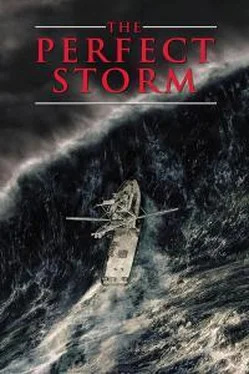Sebastian Junger - The Perfect Storm
Здесь есть возможность читать онлайн «Sebastian Junger - The Perfect Storm» — ознакомительный отрывок электронной книги совершенно бесплатно, а после прочтения отрывка купить полную версию. В некоторых случаях можно слушать аудио, скачать через торрент в формате fb2 и присутствует краткое содержание. Жанр: Триллер, Проза. Описание произведения, (предисловие) а так же отзывы посетителей доступны на портале библиотеки ЛибКат.
- Название:The Perfect Storm
- Автор:
- Жанр:
- Год:неизвестен
- ISBN:нет данных
- Рейтинг книги:3 / 5. Голосов: 1
-
Избранное:Добавить в избранное
- Отзывы:
-
Ваша оценка:
- 60
- 1
- 2
- 3
- 4
- 5
The Perfect Storm: краткое содержание, описание и аннотация
Предлагаем к чтению аннотацию, описание, краткое содержание или предисловие (зависит от того, что написал сам автор книги «The Perfect Storm»). Если вы не нашли необходимую информацию о книге — напишите в комментариях, мы постараемся отыскать её.
The Perfect Storm — читать онлайн ознакомительный отрывок
Ниже представлен текст книги, разбитый по страницам. Система сохранения места последней прочитанной страницы, позволяет с удобством читать онлайн бесплатно книгу «The Perfect Storm», без необходимости каждый раз заново искать на чём Вы остановились. Поставьте закладку, и сможете в любой момент перейти на страницу, на которой закончили чтение.
Интервал:
Закладка:
The survivors are drifting fast in mountainous seas and the chances of spotting them are terrible. Helicopters will have minimal time on-scene because they can't refuel, it's unlikely conditions would permit a hoist rescue anyway, and there's no way to determine if the guardsmen's radios are even working. That leaves the Tamaroa to do the job, but she wasn't even able to save the Satori crew, during less severe conditions. The storm is barreling westward, straight toward the ditch point, and wave heights are climbing past anything ever recorded in the area.
If things look bad for Ruvola's crew, they don't look much better for the people trying to rescue them. It's not inconceivable that another helicopter will have to ditch during the rescue effort, or that a Coast Guardsman will get washed off the Tamaroa. (For that matter the Tamaroa herself, at 205 feet, is not necessarily immune to disaster. One freak wave could roll her over and put eighty men in the water.) Half a dozen aircraft, two ships, and two hundred rescuers are heading for 39 north, 72 west; the more men out there, the higher the chances are of someone else getting into trouble. A succession of disasters could draw the rescue assets of the entire East Coast of the United States out to sea.
A Falcon jet out of Air Station Cape Cod is the first aircraft on-scene. It arrives ninety minutes after the ditching, and the pilot sets up what is known as an expanding-square search. He moves slightly downsea of the last known position—the "splash point”—and starts flying ever-increasing squares until he has covered an area ten miles across. He flies at two hundred feet, just below cloud cover, and estimates the probability of spotting the survivors to be one-in-three. He turns up nothing. Around 11:30 he expands his search to a twenty-mile square and starts all over again, slowly working his way southwest with the direction of drift. The infrared-equipped P-3 is getting ready to launch from Brunswick, and a Coast Guard helicopter is pounding its way southward from Cape Cod.
And then, ten minutes into the second square, he picks up something: a weak signal on 243 megahertz. That's a frequency coded into Air National Guard radios. It means at least one of the airmen is still alive.
The Falcon pilot homes in on the signal and tracks it to a position about twenty miles downsea of the splash point.
Whoever it is, they're drifting fast. The pilot comes in low, scanning the sea with night-vision goggles, and finally spots a lone strobe flashing below them in the darkness. It's appearing and disappearing behind the huge swell. Moments later he spots three more strobes half a mile away. All but one of the crew are accounted for. The pilot circles, flashing his lights, and then radios his position in to District One. An H-3 helicopter, equipped with a hoist and rescue swimmer, is only twenty minutes away. The whole ordeal could be over in less than an hour.
The Falcon circles the strobes until the H-3 arrives, and then heads back to base with a rapidly falling fuel gauge. The H-3 is a huge machine, similar to the combat helicopters used in Vietnam, and has spare fuel tanks installed inside the cabin. It can't refuel in midflight, but it can stay airborne for four or five hours. The pilot, Ed DeWitt, tries to establish a forty-foot hover, but wind shear keeps spiking him downward. The ocean is a ragged white expanse in his searchlights and there are no visual reference points to work off of. At one point he turns downwind and almost gets driven into the sea.
DeWitt edges his helicopter to within a hundred yards of the three men and tells his flight engineer to drop the rescue basket. There's no way he's putting his swimmer in the water, but these are experienced rescuemen, and they may be able to extract themselves. It's either that or wait for the storm to calm down. The flight engineer pays out the cable and watches in alarm as the basket is blown straight back toward the tail rotors. It finally reaches the water, swept backward at an angle of forty-five degrees, and DeWitt tries to hold a steady hover long enough for the swimmers to reach the basket. He tries for almost an hour, but the waves are so huge that the basket doesn't spend more than a few seconds on each crest before dropping to the end of its cable. Even if the men could get themselves into the basket, a shear pin in the hoist mechanism is designed to fail with loads over 600
pounds, and three men in waterlogged clothing would definitely push that limit. The entire assembly—cable, basket, everything—would let go into the sea.
DeWitt finally gives up trying to save the airmen and goes back up to a hover at two hundred feet. In the distance he can see the Tamaroa, searchlights pointed straight up, plunging through the storm. He vectors her in toward the position of the lone strobe in the distance—Graham Buschor—and then drops a flare by the others and starts back for Suffolk. He's only minutes away from "bingo," the point at which an aircraft doesn't have enough fuel to make it back to shore.
Two hundred feet below, John Spillane watches his last hope clatter away toward the north. He hadn't expected to get rescued, but still, it's hard to watch. The only benefit he can see is that his family will know for sure that he died. That might spare them weeks of false hope. In the distance, Spillane can see lights rising and falling in the darkness. He assumes it's a Falcon jet looking for the other airmen, but its lights are moving strangely; it's not moving like an aircraft. It's moving like a ship.
THE Tamaroa has taken four hours to cover the fifteen miles to the splash point; her screws are turning for twelve knots and making three. Commander Brudnicki doesn't know how strong the wind is because it rips the anemometer off the mast, but pilot Ed DeWitt reports that his airspeed indicator hit eighty-seven knots—a hundred miles an hour—while he was in a stationary hover. The Tamaroa's course to the downed airmen puts them in a beam sea, which starts to roll the ship through an arc of no degrees; at that angle, bulkheads are easier to walk on than floors. In the wheelhouse, Commander Brudnicki is surprised to find himself looking up at the crest of the waves, and when he orders full rudder and full bell, it takes thirty or forty seconds to see any effect at all. Later, after stepping off the ship, he says, "I certainly hope that was the high point of my career."
The first airman they spot is Graham Buschor, swimming alone and relatively unencumbered a half mile from the other three. He's in a Mustang survival suit and has a pen-gun flare and the only functional radio beacon of the entire crew. Brudnicki orders the operations officer, Lieutenant Kristopher Furtney, to maneuver the Tamaroa upsea of Buschor and then drift down on him. Large objects drift faster than small ones, and if the ship is upwind of Buschor, the waves won't smash him against the hull. The gunner's mate starts firing flares off from cannons on the flying bridge, and a detail of seamen crouch in the bow with throwing ropes, waiting for their chance. They can hardly keep their feet in the wind.
The engines come to a full stop and the Tamaroa wallows beam-to in the huge seas. It's a dangerous position to be in; the Tamaroa loses her righting arm at seventy-two degrees, and she's already heeling to fifty-five. Drifting down on swimmers is standard rescue procedure, but the seas are so violent that Buschor keeps getting flung out of reach. There are times when he's thirty feet higher than the men trying to rescue him. The crew in the bow can't get a throwing rope anywhere near him, and Brudnicki won't order his rescue swimmer overboard because he's afraid he won't get him back. The men on deck finally realize that if the boat's not going to Buschor, Buschor's going to have to go to it. SWIM! they scream over the rail. SWIM! Buschor rips off his gloves and hood and starts swimming for his life.
Читать дальшеИнтервал:
Закладка:
Похожие книги на «The Perfect Storm»
Представляем Вашему вниманию похожие книги на «The Perfect Storm» списком для выбора. Мы отобрали схожую по названию и смыслу литературу в надежде предоставить читателям больше вариантов отыскать новые, интересные, ещё непрочитанные произведения.
Обсуждение, отзывы о книге «The Perfect Storm» и просто собственные мнения читателей. Оставьте ваши комментарии, напишите, что Вы думаете о произведении, его смысле или главных героях. Укажите что конкретно понравилось, а что нет, и почему Вы так считаете.












